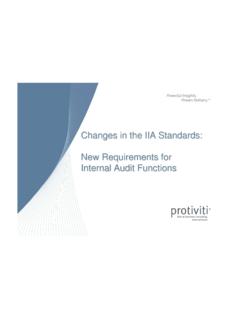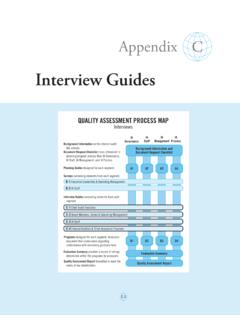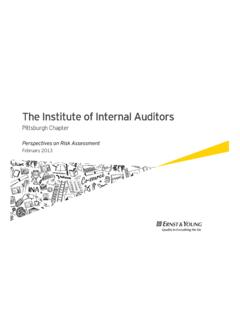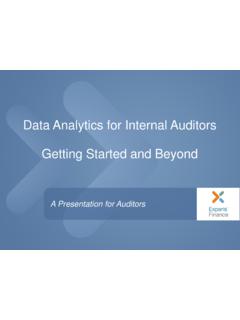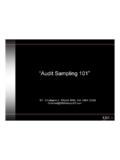Transcription of Implementation Guides - Instituut van Internal Auditors
1 1 Implementation Guides assist Internal Auditors in applying the Definition of Internal Auditing, the Code of Ethics, and the Standards and promoting good practices. Implementation Guides address Internal auditing's approach, methodologies, and consideration, but do not detail processes or procedures. They include practices relating to international, country, or industry-specific issues; specific types of engagements; and legal or regulatory issues. First Issued: 1 January, 2017 Implementation Guides Copyright 2017 by The Institute of Internal Auditors Inc. (IIA) 1035 Greenwood Blvd. Suite 401, Lake Mary, FL 32746, USA. All rights reserved. No part of this publication may be reproduced, stored in a retrieval system, or transmitted in any form by any means electronic, mechanical, photocopying, recording, or otherwise without prior written permission from the publisher.
2 The IIA publishes this document for informational and educational purposes. This document is intended to provide information, but is not a substitute for legal or accounting advice. The IIA does not provide such advice and makes no warranty as to any legal or accounting results through its publication of this document. When legal or accounting issues arise, professional assistance should be retained. 2 Implementation Guides | International Professional Practices Framework (IPPF) Table of Contents Standard 1000 Purpose, Authority, and Responsibility .. 4 Standard 1010 Recognizing Mandatory Guidance in the Internal Audit Charter .. 7 Standard 1100 Independence and Objectivity .. 9 Standard 1110 Organizational Independence.
3 13 Standard 1111 Direct Interaction with the Board .. 16 Standard 1112 Chief Audit Executive Roles Beyond Internal Auditing .. 18 Standard 1120 Individual Objectivity .. 23 Standard 1130 Impairment to Independence or Objectivity .. 26 Standard 1200 Proficiency and Due Professional Care .. 30 Standard 1210 Proficiency .. 33 Standard 1220 Due Professional Care .. 37 Standard 1230 Continuing Professional Development .. 40 Standard 1300 Quality Assurance and Improvement Program .. 43 Standard 1310 Requirements of the Quality Assurance and Improvement Program .. 48 Standard 1311 Internal Assessments .. 51 Standard 1312 External Assessments .. 56 Standard 1320 Reporting on the Quality Assurance and Improvement Program.
4 62 Standard 1321 Use of Conforms with the International Standards for the Professional Practice of Internal Auditing .. 67 Standard 1322 Disclosure of Nonconformance .. 70 Standard 2000 Managing the Internal Audit Activity .. 73 Standard 2010 Planning .. 77 Standard 2020 Communication and Approval .. 80 Standard 2030 Resource 83 Standard 2040 Policies and Procedures .. 85 Standard 2050 Coordination and Reliance .. 88 Standard 2060 Reporting to Senior Management and the Board .. 92 Standard 2070 External Service Provider and Organizational Responsibility for Internal Auditing .. 98 Standard 2100 Nature of Work .. 102 Standard 2110 Governance .. 105 3 Implementation Guides | International Professional Practices Framework (IPPF) Standard 2120 Risk Management.
5 111 Standard 2130 Control .. 115 Standard 2200 Engagement Planning .. 119 Standard 2201 Planning Considerations .. 122 Standard 2210 Engagement Objectives .. 126 Standard 2220 Engagement Scope .. 128 Standard 2230 Engagement Resource Allocation .. 130 Standard 2240 Engagement Work Program .. 133 Standard 2300 Performing the Engagement .. 135 Standard 2310 Identifying Information .. 139 Standard 2320 Analysis and Evaluation .. 142 Standard 2330 Documenting Information .. 147 Standard 2340 Engagement Supervision .. 150 Standard 2400 Communicating Results .. 153 Standard 2410 Criteria for Communicating .. 155 Standard 2420 Quality of Communications .. 158 Standard 2421 Errors and Omissions .. 161 Standard 2430 Use of Conducted in Conformance with the International Standards for the Professional Practice of Internal Auditing.
6 163 Standard 2431 Engagement Disclosure of Nonconformance .. 165 Standard 2440 Disseminating Results .. 168 Standard 2450 Overall Opinions .. 171 Standard 2500 Monitoring Progress .. 175 Standard 2600 Communicating the Acceptance of Risks .. 178 4 Implementation Guides | International Professional Practices Framework (IPPF) Getting Started The Internal audit charter is a critical document, as it records the agreed-upon purpose, authority, and responsibility of an organization s Internal audit activity. To create this document, the chief audit executive (CAE) must understand the Mission of Internal Audit and the mandatory elements of The IIA s International Professional Practices Framework (IPPF) including the Core Principles for the Professional Practice of Internal Auditing, the Code of Ethics, the International Standards for the Professional Practice of Internal Auditing, and the Definition of Internal Auditing.
7 Standard 1000 Purpose, Authority, and Responsibility The purpose, authority, and responsibility of the Internal audit activity must be formally defined in an Internal audit charter, consistent with the Mission of Internal Audit and the mandatory elements of the International Professional Practices Framework (the Core Principles for the Professional Practice of Internal Auditing, the Code of Ethics, the Standards, and the Definition of Internal Auditing). The chief audit executive must periodically review the Internal audit charter and present it to senior management and the board for approval. Interpretation: The Internal audit charter is a formal document that defines the Internal audit activity's purpose, authority, and responsibility.
8 The Internal audit charter establishes the Internal audit activity's position within the organization, including the nature of the chief audit executive s functional reporting relationship with the board; authorizes access to records, personnel, and physical properties relevant to the performance of engagements; and defines the scope of Internal audit activities. Final approval of the Internal audit charter resides with the board. Revised Standards, Effective 1 January 2017 5 Implementation Guides | International Professional Practices Framework (IPPF) This understanding provides the foundation for a discussion among the CAE, senior management, and the board to mutually agree upon: Internal audit objectives and responsibilities.
9 The expectations for the Internal audit activity. The CAE s functional and administrative reporting lines. The level of authority (including access to records, physical property, and personnel) required for the Internal audit activity to perform engagements and fulfill its agreed-upon objectives and responsibilities. The CAE may need to confer with the organization s legal counsel or the board secretary regarding the preferred format for charters and how to effectively and efficiently submit the proposed Internal audit charter for board approval. Considerations for Implementation Based on the agreed-upon elements, as noted above, the CAE (or a delegate) drafts an Internal audit charter. The IIA offers a model Internal audit charter that may be used as a guide.
10 Although charters may vary by organization, they typically include the following sections: Introduction to explain the overall role and professionalism of the Internal audit activity. Relevant elements of the IPPF are often cited in the introduction. Authority to specify the Internal audit activity s full access to the records, physical property, and personnel required to perform engagements and to declare Internal Auditors accountability for safeguarding assets and confidentiality. Organization and reporting structure to document the CAE s reporting structure. The CAE should report functionally to the board and administratively to a level within the organization that allows the Internal audit activity to fulfill its responsibilities (see Standard 1110 Organizational Independence).



